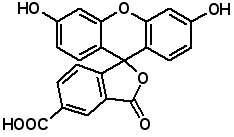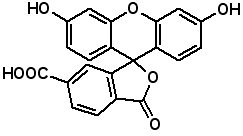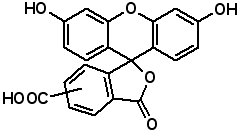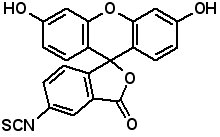|
 |
|
Featured Articles A β-Peptide Agonist of the GLP-1 Receptor, a Class B GPCR EV Denton, CJ Craig, RL Pongratz, JS. Appelbaum, AE Doerner, A Narayanan, GI Shulman, GW Cline, A Schepartz, Org. Lett., Article ASAP DOI: 10.1021/ol402568j Publication Date (Web): October 2, 2013 Copyright © 2013 American Chemical Society Previous work has shown that certain β3-peptides can effectively mimic the side chain display of an α-helix and inhibit interactions between proteins, both in vitro and in cultured cells. Here we describe a β-peptide analog of GLP-1, CC-3Act, that interacts with the GLP-1R extracellular domain (nGLP-1R) in vitro in a manner that competes with exendin-4 and induces GLP-1R-dependent cAMP signaling in cultured CHO-K1 cells expressing GLP-1R. Stapled Vasoactive Intestinal Peptide (VIP) Derivatives Improve VPAC2 Agonism and Glucose-Dependent Insulin Secretion F Giordanetto, JD Revell, L Knerr, M Hostettler, A Paunovic, C Priest, A Janefeldt, A Gill, ACS Med. Chem. Lett., Article ASAP DOI: 10.1021/ml400257h Publication Date (Web): October 16, 2013 Copyright © 2013 American Chemical Society Agonists of vasoactive intestinal peptide receptor 2 (VPAC2) stimulate glucose-dependent insulin secretion, making them attractive candidates for the treatment of hyperglycaemia and type-II diabetes. Vasoactive intestinal peptide (VIP) is an endogenous peptide hormone that potently agonizes VPAC2. However, VIP has a short serum half-life and poor pharmacokinetics in vivo and is susceptible to proteolytic degradation, making its development as a therapeutic agent challenging. Here, we investigated two peptide cyclization strategies, lactamisation and olefin-metathesis stapling, and their effects on VPAC2 agonism, peptide secondary structure, protease stability, and cell membrane permeability. VIP analogues showing significantly enhanced VPAC2 agonist potency, glucose-dependent insulin secretion activity, and increased helical content were discovered; however, neither cyclization strategy appeared to effect proteolytic stability or cell permeability of the resulting peptides. Selective, On-Resin N-Methylation of Peptide N-Trifluoroacetamides. RA Turner, NE Hauksson, JH Gipe, RS Lokey, Org Lett. 2013, 15, 5012-5015. DOI: 10.1021/ol402341u Copyright © 2013 American Chemical Society Mild and efficient methods for site-specific methylation of peptide backbone amides are important tools for chemists seeking to modulate the pharmacokinetic properties of peptide drugs. The Mitsunobu reaction was used to selectively methylate N-trifluoroacetamide (Tfa) protected peptides on-resin. The Tfa group was removed quickly and completely by reduction with excess NaBH4, and it was shown to be orthogonal to many of the protecting groups used in solid-phase peptide synthesis. Truncated Orexin Peptides: Structure–Activity Relationship Studies NA German, AM Decker, BP Gilmour, BF Thomas, Y Zhang, ACS Med. Chem. Lett., Article ASAP DOI: 10.1021/ml400333a Publication Date (Web): October 15, 2013 Copyright © 2013 American Chemical Society Orexin receptors are involved in many processes including energy homeostasis, wake/sleep cycle, metabolism, and reward. Development of potent and selective ligands is an essential step for defining the mechanism(s) underlying such critical processes. The goal of this study was to further investigate the structure–activity relationships of these peptides and to identify the truncated form of the orexin peptides active at OX1. Truncation studies have led to OXA (17–33) as the shortest active peptide known to date with a 23-fold selectivity for OX1 over OX2. Alanine, d-amino acid, and proline scans have highlighted the particular importance of Tyr17, Leu20, Asn25, and His26 for agonist properties of OXA(17–33). The conformation of the C-terminus might also be a defining factor in agonist activity and selectivity of the orexin peptides for the OX1 receptor. The Neuropeptide Galanin Benefits Insulin Sensitivity in Subjects with Type 2 Diabetes P Fang, M Yu, M Shi, B He, Z Zhang, P Bo. Curr Protein Pept Sci. 2013 Oct 4. [Epub ahead of print] Impaired insulin sensitivity, namely insulin resistance, is a metabolic and functional disorder that is often associated with the type 2 diabetes mellitus and/or obesity. Recent studies have provided compelling clues that the neuropeptide galanin is closely related to insulin sensitivity in skeletal muscle and adipose tissue of rats. This peptide may regulate glucose homeostasis and carbohydrate metabolism in peripheral tissues, as well as accelerate the translocation of glucose transporter 4 to the plasma membrane of various insulin-sensitive cells to reduce insulin resistance. Galanin plays a crucial role in inhibiting insulin secretion from pancreatic β cells to prevent hyperinsulinemia, which is a characteristic of type 2 diabetes mellitus. This review provides a comprehensive aggregation of the current literature available, bringing together data gleaned from our recent studies highlighting the role of galanin in regulating insulin sensitivity. This comprehensive role played by galanin and its relative agents in regulating insulin secretion and insulin sensitivity provides a new insight into the influence of this neuropeptide on the prevention and treatment of type 2 diabetes mellitus. Structure-guided RP-HPLC chromatography of diastereomeric α-helical peptide analogs substituted with single amino acid stereoisomers. Y Huang, L Pan, L Zhao, CT Mant, RS Hodges, Y Chen Y, Biomed Chromatogr. 2013 Oct 11. doi: 10.1002/bmc.3061. [Epub ahead of print] An α-helical model peptide (Ac-EAEKAAKE-X-EKAAKEAEK-amide) was used as a template to examine the efficacy of conventional reversed-phase high-performance liquid chromatography (RP-HPLC) in separating peptide analogs with single substitutions (at position X) of diasteromeric amino acids Ile, allo-Ile, d-Ile and d-allo-Ile. We compared differences in peptide retention behavior on a C8 column and a C18 column at different temperatures. We demonstrated how subtle differences in peptide secondary structure affected by the different substitutions of amino acids with identical overall hydrophobicity enabled effective resolution of these peptide analogs. We also demonstrated the ability of RP-HPLC to separate Ile- and allo-Ile-substituted analogs of a 26-residue α-helical antimicrobial peptide (AMP), with the substitution site towards the C-terminus of the α-helix. These peptides show different values of preantibacterial activity and hemolytic activity, and different selectivity against bacteria and human cells. Our results underline the ability of RP-HPLC to resolve even difficult diasteromeric peptide mixtures as well as its value in monitoring very subtle hydrophobicity changes in de novo-designed AMP. Copyright © 2013 John Wiley & Sons, Ltd. The Y2 receptor agonist PYY3-36 increases the behavioural response to novelty and acute dopaminergic drug challenge in mice. U Stadlbauer, E Weber, W Langhans, U Meyer, Int J Neuropsychopharmacol. 2013 Oct 17:1-13. [Epub ahead of print] The gastrointestinal hormone PYY3-36 is a preferential Y2 neuropeptide Y (NPY) receptor agonist. Recent evidence indicates that PYY3-36 acts on central dopaminergic pathways, but its influence on dopamine-dependent behaviours remains largely unknown. We therefore explored the effects of peripheral PYY3-36 treatment on the behavioural responses to novelty and to dopamine-activating drugs in mice. In addition, we examined whether PYY3-36 administration may activate distinct dopamine and ?-aminobutyric acid (GABA) cell populations in the mesoaccumbal and nigrostriatal pathways. We found that i.p. PYY3-36 injection led to a dose-dependent increase in novel object exploration. The effective dose of PYY3-36 (1 μg/100 g body weight) also potentiated the locomotor reaction to the indirect dopamine receptor agonist amphetamine and increased stereotyped climbing/leaning responses following administration of the direct dopamine receptor agonist apomorphine. PYY3-36 administration did not affect activity of midbrain dopaminergic cells as evaluated by double immuno-enzyme staining of the neuronal early gene product c-Fos with tyrosine hydroxylase. PYY3-36 did, however, lead to a marked increase in the number of cells co-expressing c-Fos with glutamic acid decarboxylase in the nucleus accumbens and caudate putamen, indicating activation of GABAergic cells in dorsal and ventral striatal areas. Our results support the hypothesis that acute administration of the preferential Y2 receptor agonist PYY3-36 modulates dopamine-dependent behaviours. These effects do not seem to involve direct activation of midbrain dopamine cells but instead are associated with neuronal activation in the major input areas of the mesoaccumbal and nigrostriatal pathways. Administration of the Y2 Receptor Agonist PYY3-36 in Mice Induces Multiple Behavioral Changes Relevant to Schizophrenia. U Stadlbauer, W Langhans, U Meyer, Neuropsychopharmacology, 2013, 38, 2446-55. doi: 10.1038/npp.2013.146. Epub 2013 Jun 10. Functional changes in neuropeptide Y (NPY) signaling at the Y2 receptor subtype have been widely implicated in stress-related neuropsychiatric illnesses such as depression and anxiety disorders. Altered Y2 receptor signaling may also play a role in the precipitation of behavioral and cognitive symptoms associated with schizophrenia. To seek preclinical evidence for this possibility, we explored the functional consequences of treatment with the selective Y2 receptor agonist PYY3-36 using translational tests for the assessment of schizophrenia-relevant behavioral and cognitive deficits in mice. We found that acute systemic administration of PYY3-36 at a low dose (1 μg/100 g body weight) or high dose (2 μg/100 g body weight) profoundly impaired social interaction without affecting innate anxiety. PYY3-36 treatment at the high dose further led to a disruption of sensorimotor gating in the form of prepulse inhibition deficiency. This effect was fully antagonized by acute treatment with the preferential dopamine D2 receptor antagonist haloperidol, but not with clozapine. In addition, both doses of PYY3-36 impaired selective associative learning in the latent inhibition paradigm and spatial working memory in a matching-to-position water maze test. The wide range of abnormalities induced by PYY3-36 suggests that signaling at the Y2 subtype of NPY receptors is critical for a number of behavioral and cognitive functions, some of which are highly relevant to schizophrenia and related psychotic disorders. At least some of the behavioral deficits induced by augmentation of Y2 receptor signaling may involve increased dopaminergic activity. |
|
β-Amino Acids and β-Homo Amino Acids
Pr = Boc, Fmoc β-peptides are resistant to proteolytic degradation making them interesting drug candidates. Antibactials, opioid peptide analogs, and drugs for cancer treatment are a few examples of the applications of β-peptides. AAPPTec offers the largest selection of competitively priced Fmoc-protected or Boc-protected β-amino acids and β-homo amino acids. AAPPTec β-amino acids and β-homo amino acids can be conveniently ordered from the online AAPPTec catalog. Custom Peptide Libraries AAPPTec provides custom peptide libraries in 96-well plates with approximately 2 μmol of lyophilized peptide in each well. AAPPTec can synthesize peptide libraries for drug discovery, high-throughput screening, and SAR studies, including alanine scans and truncation sets.
The Apex 396 is the premier productivity tool. Capable of preparing a few peptides or up to 96 separate peptides at the same time, the Apex 396 is ideal for SAR studies, optimization studies, drug discovery, and small scale peptide production.
Galanin Galanin is a neuropeptide widely expressed in the gut, brain and spinal cord of mammals. It appears to play a role in a variety of functions, including pain transmission, feeding, regulation of blood pressure, sleep and waking regulation, regulation of mood and cognition. It has been linked to epilepsy, depression, eating disorders and cancer. Recently, in a rat model of Alzheimer’s disease, administering galanin by intracerebroventricular injection improved spatial memory and lowered beta-amyloid levels in the hippocampus.
Spirit HPLC Columns
High pH reversed phase chromatography is becoming a powerful and highly useful technique in proteome analysis. It has been successfully used as a first dimension peptide separation technique in shotgun proteomic experiments.
Alkenyl Amino Acid Building Blocks for Stapled Peptides Stapled peptides are being evaluated as leads for treating cancer and HIV infection. AAPPTec offers the largest selection of commercially available alkenyl amino acids for preparing stapled peptides. To view the alkenyl amino acids available, go to our online catalog.
Peptide YY (3-36) is a Y2 receptor antagonist. It reduces food intake and modulates brain activity in the appetite centers in humans. Recently published results suggest PYY( 3-36) plays a contributory role in deoxynivalenol-induced vomiting. Administration of PYY (3-36) in mice induces multiple behavioral changes relevant to schizophrenia. Eberlein, GA; et al., Peptides, 1989, 10, 797; Acuna-Goycolea, C; van den Pol, AK., Pol. J. Neurosci., 2005, 25, 10510; Halatchev, IG; Cone, RD., Cell Metab., 2005, 1, 159; Ballantyne, GH., Obes. Surg., 2006, 16, 651; De Silva, A; et al., Cell Metab., 2011, 14, 700; Wu, W; et al., Toxicol. Sci., 2013, 133, 185; Stadlbaur, U.; Langhans, W.; Meyer, U., Neuropsychopharmacology, 2013, 38, 2446. AAPPTec offers human and canine PYY (3-36).



|
 |
UPCOMING EVENTS |
|
|
December 2013 Natural Peptides to Drugs December 8-11 |
 |


